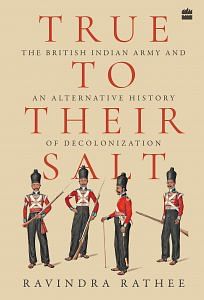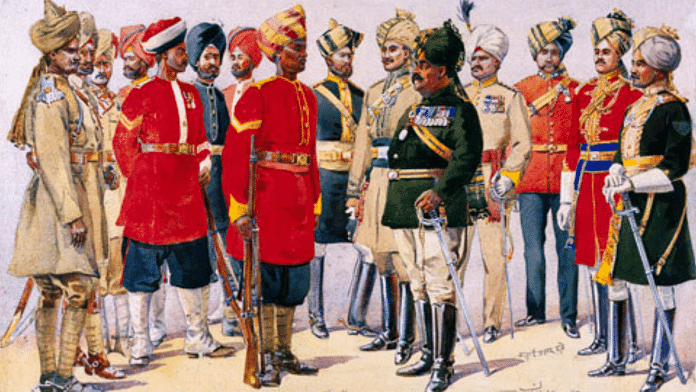The attraction of the profession of arms seen above should not come as a surprise to those acquainted with the ancient traditions of India. In the segmented societal order, the right to bear arms carried a degree of sanctity with it. This sanctity came from the expectation of conducting oneself according to ‘dharma’, a code of righteous conduct. Those who had the good fortune to bear arms did so to protect and nurture dharma, and hence were obliged to follow the righteous path. The soldier thus had to follow a complex, uncoded set of behaviours suitable to his status as the protector of dharma.
Many authors have tried to describe the soldier’s conduct in terms of notions of honour, shame, duty, righteousness, etc. No doubt these were all important traits. However, the overarching trait underlining the ancient soldier’s behaviour and code of conduct was renunciation. The act and symbolism of renunciation is the core of virtues defined for collective as well as individual actions in the ancient texts of India. The ability to renounce, to discard and walk away, is the source of the power of the yogi, the king and the kshatriya—the soldier—alike.
The power of a ‘yogi’ is derived from his ability to renounce the material word and its pleasures. The one who has no value for the matter is considered enlightened, and on the path to ‘moksha’ or liberation. The yogi has the highest status in the societal order per ancient scriptures. An ordinary person too moves through the four ‘ashramas’ (stages) in life, which are progressively geared towards renunciation, the last ashram being of ‘vanvas’ (hermit or forest dweller). This material renunciation is the background, path and preparation for the hopeful spiritual renunciation: moksha or freedom from the cycle of rebirth. The biggest yogi is Lord Shiva himself, who renounced the world and lives like a hermit in the barren Himalaya mountains or in graveyards. Lord Rama—considered to be an avatar of Lord Vishnu—is revered as an ideal man for his ability to renounce his kingdom for fourteen years to honour his father’s word, while suffering the life of a hermit in the
forests.
A soldier, in this worldview, has to be prepared to renounce his greatest possession—his life—in the righteous path of dharma (roughly translated in this context as duty). The king is the epitome of an ideal kshatriya: the soldier. The soldier has to be prepared to give the final gift—this life and the world—when his other worldly acts are insufficient to uphold dharma.
Dharma has different implications in different contexts, but fulfilling one’s duty is one of its key aspects. It is a soldier’s duty to follow his leader, and serve according to the righteous path set out for him. This normative paradigm has continued to inform the spirit and culture of warrior classes in India since antiquity.
The skills of a warrior were held in high esteem, and the ruling classes justified their claims based on their military capabilities, which were essential to carrying out their duties. Military valour and arms training were coveted skills, and separated the kshatriyas from the rest. This kshatriya tradition was imbibed by the Rajputs, and subsequently other fighting classes like Marathas, Jats, Sikhs, Gurkhas, and even Muslim soldiers, many of whom remembered their Rajput and Jat ancestors after conversion.
Also read: Indian history without the Deccan is like European history minus France
The skilled warrior Arjun in the epic Mahabharata wavers before the final war as he sees his relatives arrayed against him on the battlefield. His charioteer, who is no less than Lord Krishna himself, reminds him of his duty as a kshatriya in these words:
“Considering your specific duty as a kshatriya, you should know that there is no better engagement for you than fighting on principles; and so there is no need for hesitation. O Partha, happy are the kshatriyas to whom such fighting opportunities come unsought opening for them the doors of heavenly planets. If, however, you do not perform your religious duty of fighting, then you will certainly incur sins for neglecting your duties and thus lose your reputation as a fighter. People will always speak of your infamy, and for
a respectable person, dishonour is worse than death.”
The classic ‘kshatriya’ battle fought ‘fairly’ was a contest between skilled warriors in an almost ritualistic observance of the code and formalities. There is an illustrative description of such a combat, quoted by Norman Ziegler from a sixteenth-century Rajput
court epic: “Then Kumbho got down [from his horse] … went into the camp and bowed to Hemo. Hemo said, ‘Very fine, Kumbho!’ Then Hemo said, ‘Kumbho! You inflict a wound.’ Kumbho said, ‘Hemoji! You inflict a wound.’ Hemo said, ‘Kumbho! You are a boy. I have had nim leaves bandaged on many [a wound].’ Then Kumbho was saying, ‘Hemoji! You inflict a wound.’ Hemo said, ‘Kumbho! Your body has yet felt no sword; you are a boy. You inflict a wound. I am an elder; why should I inflict the [first] wound?’ Kumbho said, ‘Hemoji! In years you are elder, but in rank I am senior. You have taken my grain in the hem of your clothes; you are my military servant [and] therefore, I am senior; you inflict [the first] wound.’ Then Hemo said, ‘What should I do? You allow me no choice.’ Then Hemo wounded Kumbho. The blow [of his sword] severed Kumbho’s helmet, split [his] skull [as though smashing] a clay bowl, sliced between his eyebrows and lodged [itself] at the top of his ear. Kumbho inflicted a wound; [he] cut Hemo in two parts. Hemo fell down. Then Kumbho drew his dagger and stabbed [it] into Hemo’s chest.”
Such elaborate and exaggerated politeness shown by two combatants might be doubtful. However, this story sets an example of the conduct to be followed by warriors, as part of
their ethos. Personal bravery and an absence of fear of death were virtues expected of all warriors. Equally important was the loyalty and the patron–client relationship. Loyalty to the master was considered a sacred obligation by a warrior.
In the south, when Tanjavur ruler Vijayvarghava’s son was cut down before his own eyes by overwhelming Madurai forces in 1673, Vijayvarghava realized he himself was doomed. When Madurai matchlock men attacked him, he called out to the Madurai ruler: ‘You must order your men not to shoot their guns but to fight only with swords and spears. Do you want to know why? Because if one dies from some lousy bullet shot from a distance, he fails to enter heaven—that is nothing like a warrior’s death. Don’t you know all this yourself?’
The wish was granted and the Tanjavur ruler rushed at his opponents, sword in hand, and attained the right kind of death in the right kind of fighting. The supreme manifestation of this culture of renunciation of the ascetic warrior was the custom of ‘saka’ and ‘jauhar’. When faced with an overwhelming enemy and certain defeat, the defending warriors would ride out or rush at their opponents, sword in hand, facing almost certain death. This final ritual charge of the warrior is the ultimate act of renunciation, and was frequently adopted
during many conflicts in India. While men performed this ritual saka, the unarmed women would consign themselves to the eternal flame, in the ritual of jauhar, to escape torture, rape and dishonour at the hand of the victorious foe.
 This excerpt from ‘True to Their Salt’ by Ravindra Rathee has been published with permission from HarperCollins.
This excerpt from ‘True to Their Salt’ by Ravindra Rathee has been published with permission from HarperCollins.



